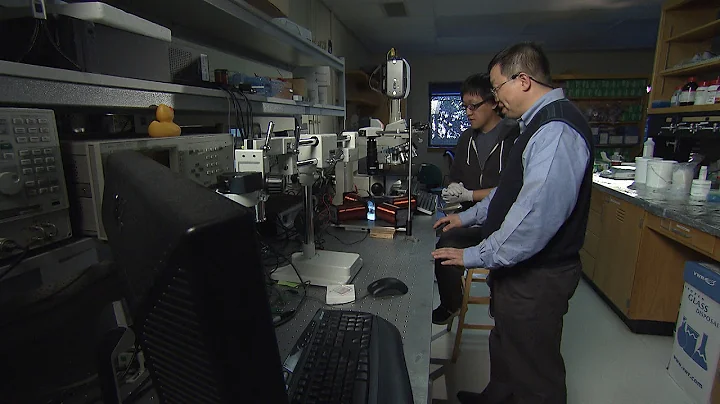Yiping He
age ~59
from Lancaster, PA
- Also known as:
-
- Yingo He
- Yipping He
- Yiping Liu
- Ping He Yi
- He Yingo
- Phone and address:
-
1053 Olde Hickory Rd, Lancaster, PA 17601
(717)5691312
Yiping He Phones & Addresses
- 1053 Olde Hickory Rd, Lancaster, PA 17601 • (717)5691312
- Maple Glen, PA
- Jacksonville, FL
- 57 Redcedar Cir, Collegeville, PA 19426 • (610)8315648
- 946 Eagle Hts, Madison, WI 53705
- Audubon, PA
Us Patents
-
Identification Of Targets Of Antimicrobial Compounds
view source -
US Patent:20020086310, Jul 4, 2002
-
Filed:Aug 30, 2001
-
Appl. No.:09/942487
-
Inventors:Frank Fan - Collegeville PA, US
Yiping He - Collegeville PA, US
Jianzhong Huang - Collegeville PA, US
Xinhe Jiang - Collegeville PA, US
Damien McDevitt - Collegeville PA, US
Martin Rosenberg - Royersford PA, US
Annemarie St. John - King of Prussia PA, US -
International Classification:C12Q001/68
C12Q001/18 -
US Classification:435/006000, 435/032000
-
Abstract:A method of determining the cellular or genetic target of an antimicrobial compound includes cloning of a bacterial gene into an expression vector with an inducible promoter and determining whether increasing expression of the cloned gene in the cell will result in resistance to an antimicrobial compound. Also, the method can include incorporation of every gene of a bacterial strain into expression vectors having an inducible promoter, induction, treating with an antimicrobial compound, isolating the gene clone that confers cells resistant to the compound, and determining the identity of the resistant gene by various methods including DNA microarrays and gene sequencing.
-
Modulating Lymphoid Commitment And Survival
view source -
US Patent:20030181380, Sep 25, 2003
-
Filed:Mar 10, 2003
-
Appl. No.:10/385591
-
Inventors:Warren Pear - Philadelphia PA, US
David Allman - Havertown PA, US
Yiping He - Philadelphia PA, US
David Izon - Wembley, AU
Jon Aster - Lexington MA, US -
International Classification:A61K038/17
-
US Classification:514/012000
-
Abstract:Provided are methods for manipulating aspects of lymphopoiesis by modulating and controlling Notch signaling, thereby providing treatment for diseases of the immune system. Accordingly, there are provided methods for selectively modulating T cell fate commitment of a common lymphoid progenitor at the expense of B cell fate commitment, and in the converse for selectively modulating B cell fate commitment of a common lymphoid progenitor at the expense of T cell fate commitment. Also provided are methods for treating patients suffering from a disease or disorder of T cell origin, or conversely of B cell origin. Further provided are methods for selectively killing B cells in a committed population of B cells, such as in a patient suffering from B cell leukemia or lymphoma; as well as methods for selectively killing T cells in a committed population of T cells such as in a patient suffering from diseases of T cell origin.
-
Identification Of Targets Of Antimicrobial Compounds
view source -
US Patent:20040029201, Feb 12, 2004
-
Filed:Jul 11, 2003
-
Appl. No.:10/617988
-
Inventors:Frank Fan - Collegeville PA, US
Yiping He - Collegeville PA, US
Jianzhong Huang - Collegeville PA, US
Xinhe Jiang - Collegeville PA, US
Damien McDevitt - Collegeville PA, US
Martin Rosenberg - Royersford PA, US
Annemarie St, John - King of Prussia PA, US -
Assignee:SmithKline Beecham Corporation and SmithKline Beecham p.I.c.
-
International Classification:G01N033/574
-
US Classification:435/007230
-
Abstract:A method of determining the cellular or genetic target of an antimicrobial compound includes cloning of a bacterial gene into an expression vector with an inducible promoter and determining whether increasing expression of the cloned gene in the cell will result in resistance to an antimicrobial compound. Also, the method can include incorporation of every gene of a bacterial strain into expression vectors having an inducible promoter, induction, treating with an antimicrobial compound, isolating the gene clone that confers cells resistant to the compound, and determining the identity of the resistant gene by various methods including DNA microarrays and gene sequencing.
-
Identification Of Targets Of Antimicrobial Compounds
view source -
US Patent:20060240505, Oct 26, 2006
-
Filed:Jun 28, 2006
-
Appl. No.:11/427043
-
Inventors:Frank Fan - Collegeville PA, US
Yiping He - Collegeville PA, US
Jianzhong Huang - Collegeville PA, US
Xinhe Jiang - Collegeville PA, US
Damien McDevitt - Collegeville PA, US
Martin Rosenberg - Royersford PA, US
Annemarie St. John - King of Prussia PA, US -
International Classification:C12Q 1/18
C12N 1/21
C12N 15/74 -
US Classification:435032000, 435471000, 435252300
-
Abstract:A method of determining the cellular or genetic target of an antimicrobial compound includes cloning of a bacterial gene into an expression vector with an inducible promoter and determining whether increasing expression of the cloned gene in the cell will result in resistance to an antimicrobial compound. Also, the method can include incorporation of every gene of a bacterial strain into expression vectors having an inducible promoter, induction, treating with an antimicrobial compound, isolating the gene clone that confers cells resistant to the compound, and determining the identity of the resistant gene by various methods including DNA microarrays and gene sequencing.
-
High Efficiency Partial Distributed Feedback (P-Dfb) Laser
view source -
US Patent:20080205476, Aug 28, 2008
-
Filed:Jul 13, 2007
-
Appl. No.:11/777913
-
Inventors:Manoj KANSKAR - Madison WI, US
Yiping HE - Madison WI, US
Steven H. MACOMBER - Tucson AZ, US -
International Classification:H01S 3/08
H01L 21/02 -
US Classification:372 96, 372102, 438 22, 257E21002
-
Abstract:A second-order multi-mode partial distributed feedback (p-DFB) laser having increased electrical-to-optical power conversion efficiency, stabilized wavelength and narrowed emission linewidth. The laser includes an abbreviated grating housed in the laser cavity that is separated from both the front-end and the back-end of the laser facets.
-
High Efficiency Distributed Feedback (Dfb) Laser With Low-Duty Cycle Grating
view source -
US Patent:20080212635, Sep 4, 2008
-
Filed:Feb 25, 2008
-
Appl. No.:12/036809
-
Inventors:Manoj Kanskar - Madison WI, US
Yiping He - Madison WI, US
Steve H. Macomber - Tucson AZ, US -
Assignee:Alfalight, Inc. - Madison WI
-
International Classification:H01S 5/00
H01L 33/00 -
US Classification:372 501, 372102, 438 32, 257E33001
-
Abstract:The invention provides a grating for a distributed feedback laser having decreased diffraction loss with reduced +/−1 order diffraction and scattering loss resulting from the reduced imperfections in the grating fabrication. In various embodiments, the grating has a low duty cycle wherein the ratio of the length of the low-index portion ‘a’ to the length of the pitch of the grating ‘b’ is less than 0.5. Further, in some preferred embodiments, the invention includes a laser, the laser comprising a distributed feedback laser wherein the laser includes a grating having less diffraction and less scattering loss. In various exemplary embodiments, the grating is further a partial grating, thereby providing increased efficiency resulting from a decrease in first-order diffraction loss due to the grating being separated from the front and rear facets and in some exemplary embodiments being situated at the area of lowest electric filed.

He Yiping
view source
Yiping He
view source
YiPing He
view sourceFriends:
Leon Zhong, Stefan Daniels
Myspace
Googleplus

Yiping He
Youtube
Get Report for Yiping He from Lancaster, PA, age ~59





